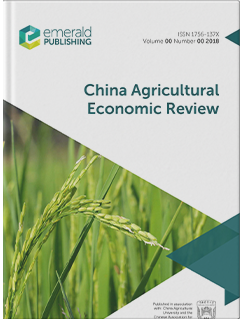消费者会通过草畜平衡认证标签帮助青藏高原实现可持续发展吗?
IF 4.6
2区 经济学
Q1 AGRICULTURAL ECONOMICS & POLICY
引用次数: 2
摘要
目的青藏高原环境和生态系统脆弱,草原保护与经济发展的矛盾和冲突突出。如何在不损害当地居民经济福利的情况下促进高原的可持续放牧,是中国政府面临的一个关键挑战。本研究通过评估消费者对牦牛产品草畜平衡认证的偏好和价值,探讨了基于市场的草原保护政策的潜力。设计/方法/方法本研究采用选择试验,选取牦牛肉料畜平衡认证、饲养类型、屠宰年龄和价格等4个属性。一家专业的在线调查公司从北京、上海、武汉、广州和成都收集了2999名受访者的样本。结果显示,中国城市消费者最愿意为草食平衡认证的牦牛肉品支付最高的溢价,其次是草食认证的肉品。消费者对谷物饲料(2岁和4岁以上屠宰的牦牛的肉)的平均评价为负面。异质性分析表明,女性、年轻、已婚、受教育程度较高、收入中位数以上、有西藏旅游或牦牛消费经历的个体更容易接受草畜平衡认证。原创性/价值这是第一个通过关注消费者对草畜平衡认证的评估来探索草原保护需求驱动机制的研究。本文章由计算机程序翻译,如有差异,请以英文原文为准。
Would consumers help achieve sustainable development in the Qinghai–Tibet Plateau with a forage–livestock balance certification label?
PurposeThe contradiction and conflict between grassland conservation and economic development are prominent in the Qinghai–Tibet Plateau (QTP) with its fragile environment and ecosystem. How to promote sustainable grazing in the plateau without hurting the economic welfare of local residents is a key challenge facing the Chinese government. This study explores the potential of market-based grassland conservation policies by evaluating consumer preferences and valuations for forage–livestock balance certification labeled yak products.Design/methodology/approachThis study adopts a choice experiment with four attributes of yak meat, including forage–livestock balance certification, feeding type, age at slaughter and price. A sample size of 2,999 respondents from Beijing, Shanghai, Wuhan, Guangzhou and Chengdu was collected by a professional online survey company.FindingsThe result reveals that urban Chinese consumers are willing to pay highest price premiums for forage–livestock balance certified yak meat, followed by grass-fed claim labeled meat. Consumers on average place negative valuations for grain-fed claims, meat from yak slaughtered above 2 and 4 years old. Heterogeneous analysis indicates that individuals who are female, younger, married, and better educated, and with above median income, Tibet travel or yak consumption experience, are more receptive to the forage–livestock balance certification.Originality/valueIt is the first study to explore demand-driven mechanisms for grassland conservation by focusing on consumer valuation for the forage–livestock balance certification.
求助全文
通过发布文献求助,成功后即可免费获取论文全文。
去求助
来源期刊

China Agricultural Economic Review
AGRICULTURAL ECONOMICS & POLICY-
CiteScore
9.80
自引率
5.90%
发文量
41
审稿时长
>12 weeks
期刊介绍:
Published in association with China Agricultural University and the Chinese Association for Agricultural Economics, China Agricultural Economic Review publishes academic writings by international scholars, and particularly encourages empirical work that can be replicated and extended by others; and research articles that employ econometric and statistical hypothesis testing, optimization and simulation models. The journal aims to publish research which can be applied to China’s agricultural and rural policy-making process, the development of the agricultural economics discipline and to developing countries hoping to learn from China’s agricultural and rural development.
 求助内容:
求助内容: 应助结果提醒方式:
应助结果提醒方式:


